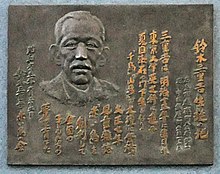Suzuki Miekichi
Suzuki Miekichi ( Japanese 鈴木 三重 吉 ; born September 29, 1882 , † June 27, 1936 in Hiroshima ) was a Japanese novelist and children's book author. He is considered the father of children's and youth literature in Japan.
Life
After studying English literature at the Imperial University of Tokyo , Suzuki worked as a middle school teacher and wrote novels on the side. However, he himself found his talent as a novelist to be inadequate and gave up writing again in 1915.
It is thanks to his daughter that he began to write literature for children. From 1918 he published the magazine Akai Tori ( 赤 い 鳥 , Eng. "Red Bird") and asked famous writers to write for the magazine. Some outstanding works by well-known writers of the Taishō period such as Akutagawa Ryūnosuke , Arishima Takeo ( 有 島 武 郎 ) or Kitahara Hakushū ( 北 原 白 秋 ) were created for this magazine, and the genre of children's literature began to gain recognition as an art form.
Suzuki Miekichi died in 1936 at the age of 54 of complications from lung cancer . With his death, his magazine was discontinued after 196 issues.
price
Since 1948, the twelfth anniversary of Suzuki's death, the Suzuki Miekichi Prize has been awarded in Japan for outstanding children's stories, poems and songs.
monument
In Hiroshima Peace Park , between numerous memorial stones and monuments commemorating the atomic bombing on Hiroshima on August 6, 1945, there is a memorial to Suzuki Miekichi directly opposite the atomic bomb dome on the river bank. It comes from the artist and sculptor Entsuba Katsuzō , was completed in 1964 and set up not far from Suzuki's parents' house in what was then Sarugaku-chō (today's Ōtemachi, Naka-ku). It is often mistakenly interpreted as a memorial in connection with the atomic bomb, especially by foreign tourists.
The memorial consists of two parts: on the left a bust of Suzuki on a granite pedestal in the form of a book, on which " 鳥 い 赤 " ( red bird , in the same traditional Japanese spelling from right to left as the earlier magazine title) is written, and on the right a granite block with two bronze children sitting. Below it can be read in Suzuki's handwriting from top to bottom:
| 私 は 永久 に 夢 を 持 つ | I will have dreams forever |
| た だ 年少 時 の ご と く | just like a little boy |
| た め に 悩 む こ と 浅 き の み | therefore my worries and fears will never be too deep |
| 三重 吉 | Miekichi |
| personal data | |
|---|---|
| SURNAME | Suzuki, Miekichi |
| ALTERNATIVE NAMES | 鈴木 三重 吉 (Japanese) |
| BRIEF DESCRIPTION | Japanese novelist and children's book author |
| DATE OF BIRTH | September 29, 1882 |
| DATE OF DEATH | June 27, 1936 |
| Place of death | Hiroshima |

